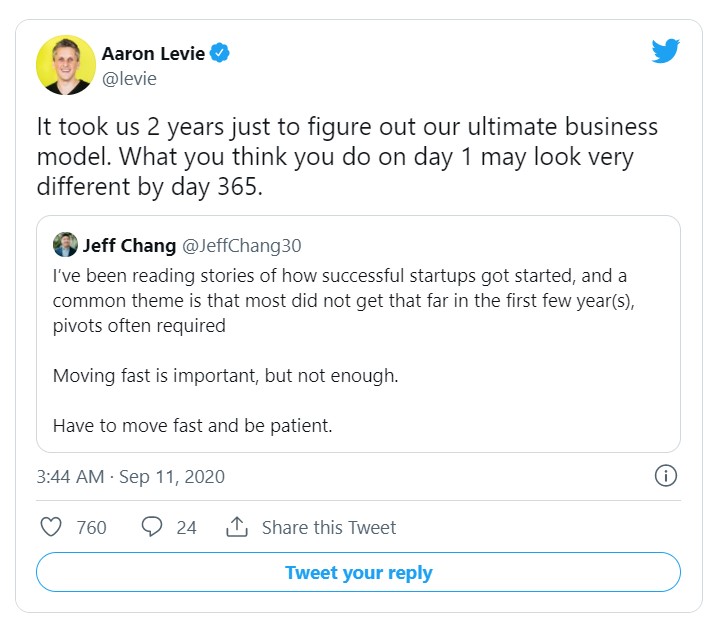Box CEO Aaron Levie gave the following advice in response to a tweet about the early stages of successful startups:
“It took us 2 years just to figure out our ultimate business model,” the executive tweeted. “What you think you do on day 1 may look very different by day 365.”
The insight supported a common theme: successful SaaS businesses tend to work through many changes along their growth journey.
And that certainly worked for Box. The content management and collaboration platform earned $770.7 million in annual revenue as of 2021, despite its initial struggles.

If only the tweet had gone into a little more detail on how they did it!
Boosting ARR takes startup-like energy
As subscription businesses scale, their strategies understandably change. What works to get the first hundred customers doesn’t always work to get the 500th or 1,000th customer.
However, those early days are often marked by enthusiasm and grit—nothing’s more important than securing contractually obligated revenue from customers. Creativity and the willingness to take chances are often sources of profound innovation to bring in as many subscriptions as possible.
To reach the monthly recurring revenue (MRR) and annual recurring revenue (ARR) of a big SaaS brand, businesses must continue to foster this ingenuity even as the business evolves.
A short supply of ingenuity at later growth stages can drag ARR down. Fortunately, your SaaS company can rejuvenate its strategies with some of that early-startup energy.
Here are a few ARR-boosting strategies that might be worth resurrecting from your startup days.
1. Stay true to your mission and vision.
When was the last time you looked at your business’s vision or mission statement? If it’s been a while, it may be time to dust it off.
As your subscription business scales, ARR growth opportunities flow in from all directions. It’s easy to lose focus when that happens. Building new features and even products to suit growing customer needs and expanding into new markets and industries is great. However, you have to make sure everything fits with your SaaS business’s vision.
Strategic, focused ARR growth is centered on your primary objective. Revisit your vision or mission statement and ask yourself these questions.
- Does this statement still resonate with the business?
- Does it resonate with the business’s core customer base?
- Are business decisions we’re making today aligned with this statement?
Bring your teams into the conversation, as well. Decide whether there’s a need to recalibrate your business strategy or even update your vision or mission statement.
2. Be willing to experiment and, yes, fail.
In the early days, you probably did a lot of experimenting and failing. It’s kind of par for the course in SaaS startups, and the failures provide valuable lessons that get carried forward with the business.
Over time though, you hopefully cumulated more and more wins. These successes are certainly worth celebrating, but they can have a downside too.
The more successful a SaaS business is, the more failure-avoidant its leaders tend to become. No one wants to be responsible for the downfall of a rising unicorn or decacorn. Studies support this, suggesting the higher the risk—and the bigger the potential loss—the more susceptible entrepreneurs are to fear of failure.
This fear holds SaaS businesses back.
To reinvigorate your business and foster rising annual recurring revenue gains, you need to be willing to take calculated risks. Informed decision-making plays a big role here.
Leverage data-rich technology, insights, and analysis to tinker with your strategies. Make temporary changes or use cohorts to continually iterate on methodologies. Stay agile.
3. Keep your customers in focus.
When you’re a startup with just a handful of customers, it’s easy to give each customer a lot of attention. Without a doubt, this has positive effects on customer satisfaction, retention, and word-of-mouth referrals. It also contributes to the value of your customers’ subscription costs.
But as you scale, that individualized attention can become harder to provide. It takes a little creativity to make this personalization part of your business’s DNA, but it’s worth the effort to avoid the revenue lost.
In fact, HubSpot found that just a 5% increase in customer retention led to a profit increase of 25%.
Rise to this challenge. Connect with your customers continually to listen to their experiences and needs. Some ideas for this include:
- random surveys
- exit surveys when customers churn out
- customer service feedback surveys, and
- user communities.
On top of listening to customers, create scalable, repeatable processes to ensure a consistently excellent customer experience. Work to maintain great perceived and measurable value in your product too. In this day and age, how customers feel when using those yearly subscriptions is just as important as providing the value they feel compelled to tell friends and colleagues about.
4. Pick the right people.
As a startup with only a handful of employees, you likely made sure you had the right people to take you into the future. That shouldn’t change just because your team has grown 10 or 100X.
As Jason Lemkin of SaaStr puts it, “once you hit just $2M in ARR, and maybe even much earlier—every great hire will be accretive.”
He supports this with simple explanations.
- A great sales VP can easily close 20-50% more sales in a year than your business would without one.
- A great marketing VP should land at least another 20-30% in lead flow.
- Great sales reps conservatively increase sales by 20%-30%, and often much more.
- Great customer success managers help retain customers and boost renewals, which are critical to ARR.
…and so on.
Thanks to numbers like this, it’s impossible to ignore how important picking the right people—not the affordable ones—is to your SaaS business’s annual recurring revenue. Pick the right people, and their work will pay for them many times over.
5. Be open to operational change.
Startups are agile. Without the burden of legacy systems and fixed mindsets, they can quickly identify and target customer needs. Startup leaders come up with clever, efficient solutions both for their customers and for their own internal processes.
Over time, however, those processes become ingrained, technology ages, and change becomes more difficult. The startup becomes the ship that’s too big to turn quickly. This cuts into that initial agility—and ARR potential.
Saying “this is how we’ve always done it” is the kiss of death for innovation. Instead, audit and analyze processes and embrace technology that ensures continued efficiency and scalability, even as things change.
Much like iterating on pricing helps to increase recurring revenue, so does iterating on operations. Search for scalable solutions that enable ongoing adaptation rather than a one-time “glad that’s over with” transition.
Digital transformation is dynamic, not static.
6. Never lose sight of churn rate.
When using data scraping techniques to acquire new customers, the issue of churn may appear less concerning. This is particularly true when compared to the early days of struggling with only a handful of customers.
However, churn is the silent killer of many a SaaS business. It quietly undermines ARR in increments, and it can be easy to miss that lost revenue until it’s too late.
This is especially troubling when there are loads of ways to increase expansion revenue and achieve negative churn. Negative churn does the opposite of churn, contributing to revenue instead of undermining it.
Always stay tuned into your churn rate and the reasons why your customers are churning. Don’t forget those exit surveys! And, of course, work on issues customers bring to your attention.
With retention and expansion efforts combined, it’s possible to reverse churn and turn your efforts into a contributor to ARR growth. That’s how you know you’ve really won.
Harnessing cycles to maximize annual recurring revenue
In many ways, running a successful SaaS business is about recognizing and leveraging cycles. Whether revisiting your startup days for inspiration or taking advantage of seasonal swings, boosting ARR takes careful attention and thoughtful strategy.
With business tools that provide data and an innovative team by your side that isn’t afraid to be innovative and take those calculated risks, your SaaS business can make the most of ingenuity and experience so that the next time you calculate ARR, you see those numbers soar.






